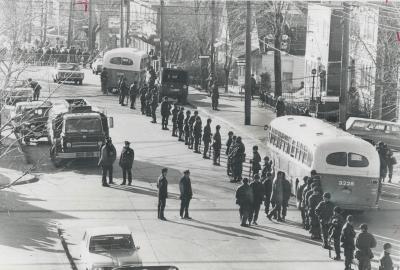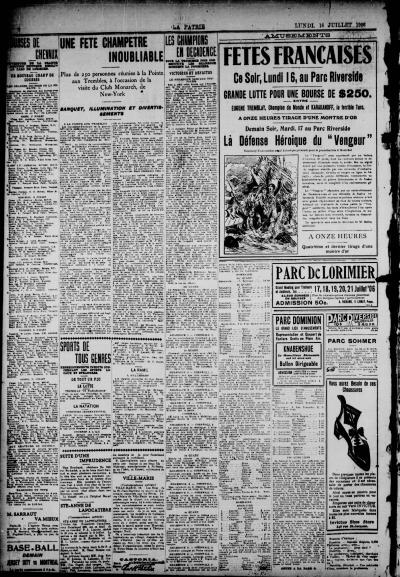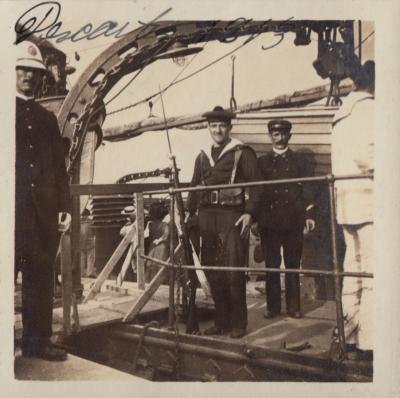Día de Los Muertos, or Day of the Dead, has been celebrated in Mexico for over 3,500 years. In October and November 2011, the City of Montréal threw a celebration of its own.
Fête des Morts
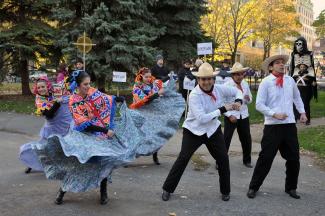
During the 2000s, the Mexican community grew substantially after a new wave of immigration. By 2011, Montréal was home to 83.9% of the 25,045 Mexicans who had settled in Quebec, 76.3% of whom had arrived in the last 10 years; most came for economic or political reasons. This vibrant community has kept its traditions and celebrations alive and shared them with Montréalers of all origins. One of them is Día de los Muertos.
Día de Los Muertos in Mexico
Día de Los Muertos has been celebrated in Mexico for over 3,500 years. It marks the transitory return to Earth of deceased loved ones. It is celebrated near the end of October and beginning of November, after the maize harvest. To help the spirits return to Earth, the family of the deceased decorate the path from the cemetery to the family home with flower petals, candles, and handicrafts, and they set up an altar to honour them. In the cemetery, people leave offerings of sugar skulls or tequila near headstones, and bring the favourite dishes of the deceased—everything prepared with great care to honour their departed loved ones. The ambiance at the cemetery is a festive one: people eat, dance, and sing, and recount old stories of the departed to help their memory live on—and in the belief that the performance of these rituals is able to attract prosperity.
Fête des Morts
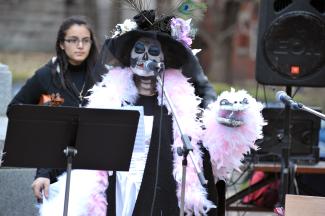
Día de los Muertos in Mexico blends pre-Hispanic religious rites with Catholic feast days introduced by the Europeans in the sixteenth century. In 2003, the holiday was recognized by UNESCO as an intangible cultural heritage. Five years later, the “Indigenous festivity dedicated to the dead” was included on the Representative List of Intangible Cultural Heritage of Humanity.
A first Día de Los Muertos celebration in Montréal
Fête des Morts
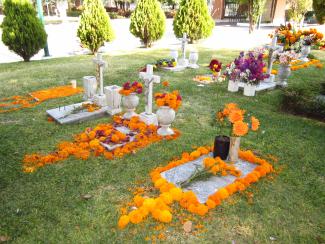
In 2011, a project to share Día de Los Muertos celebrations with Montrealers began taking shape. Every year, the Mexican Consulate prepares an altar, but an event was being planned to reach a wider public, in partnership with the MEM – Centre de mémoires montréalaises, Espacio Mexico, and the Écomusée de l’Au-Delà. Heading the project was Mariana Castellanos, who was working as an intern at the time. Castellanos, who is of Mexican descent, helped plan Día de Los Muertos activities across the city: a workshop to make ofrendas (offerings), an event for the commemorative altar at the Mexican Consulate, and a large gathering in Dorchester Square and Place du Canada, on the grounds of the former Saint-Antoine cemetery. The choice of this site for the celebrations was symbolic: between 1799 and 1854, the Saint-Antoine Catholic cemetery held the graves of thousands of Montrealers, mainly victims of cholera and typhus epidemics. The 2011 ceremony was dedicated to their memory.
The ceremony carved space for reflection around death and burial, exploring Mexican and Québec death rites: a symbolic funeral procession with a casket in recognition of Québec customs and a Mexican procession to honour the deceased at the gravesite. Several artists performed, including the string ensemble MiàSol, Mexican folk and traditional-fusion groups Yohualichan and SoNSuRyLuNa, and the Nadxieli ballet. Mariana Castellanos noted the crowd of Montrealers from the Mexican community who came out to this inaugural Día de Los Muertos celebration. She believes that, in tying in practices and rites around death and funerals, it was a perfect starting point to spark cultural exchanges.
Día de Los Muertos after 2013
Fête des Morts
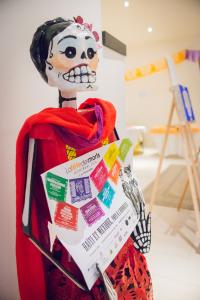
A second edition of the Día de Los Muertos celebration was held in 2013, featuring new activities. Mariana Castellanos, who had been hired by the Mexican Consulate, prepared the altar that year and organized a range of activities as part of the celebration, including cooking workshops and a project exploring death at the funeral home Memoria.
In 2014, Castellanos worked independently to organize activities around the theme of death with the Haitian community, including an exhibition entitled Offrandes : trois façons de vivre la mort, Québec, Mexique et Haïti (Offerings: Three experiences of death, from Quebec to Mexico and Haiti) at Artothèque. The exhibition showcased works which featured different funerary customs in all three countries. A workshop on the theme of death accompanied the celebration. The following year, an exhibition-pathway at Artothèque evoking funeral processions, a talk at the Musée Marguerite Bourgeoys crypt, and a sugar-skull workshop for kids were offered as part of celebrations in early November. In 2016, the Écomusée de l’Au-Delà, an organization that promotes conservation, restauration, and safekeeping of cemeteries, hosted “Brunch des Morts” to celebrate the institution’s 25th anniversary with different presentations about funerary customs as part of Día de Los Muertos.
Fête des Morts

Since 2011, celebrations for Día de Los Muertos have allowed Montrealers of all origins to get to know Mexican funerary customs, as well as to explore traditional practices around death in Québec and Haiti and how they have changed over time.
CATELLANOS, Mariana. Dossier de recherche pour la préparation de la Fête des morts 2011, Centre d’histoire de Montréal, 2011.
QUÉBEC. Ministère de l’Immigration et des Communautés culturelles. Portrait statistique de la population d’origine ethnique mexicaine recensée au Québec en 2011, Direction de la recherche et de l’analyse prospective, [En ligne], 2014.
http://www.quebecinterculturel.gouv.qc.ca/publications/fr/diversite-ethn...

